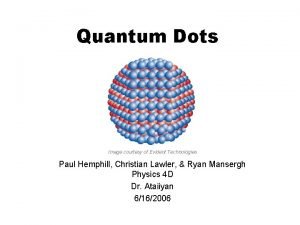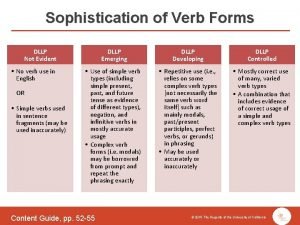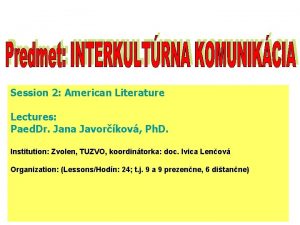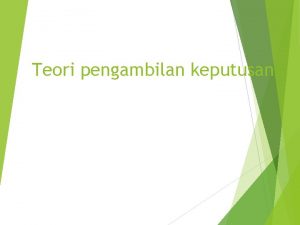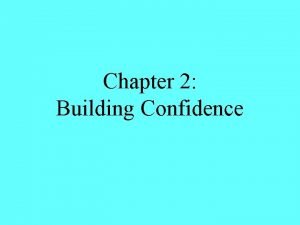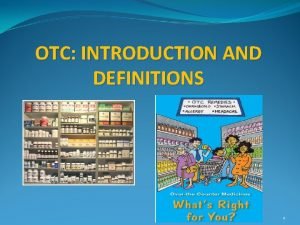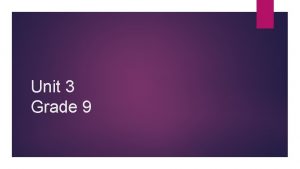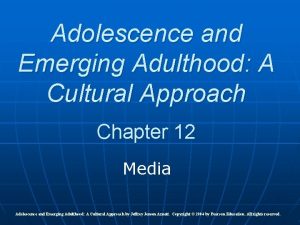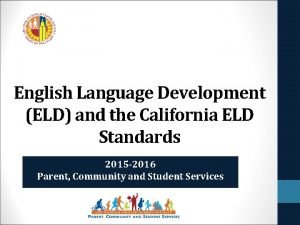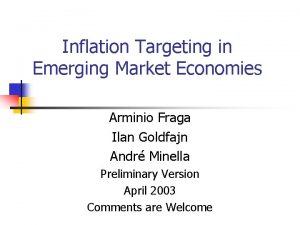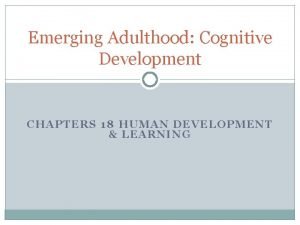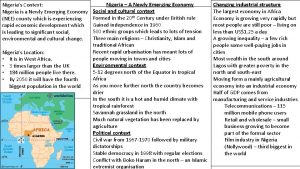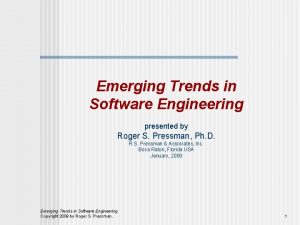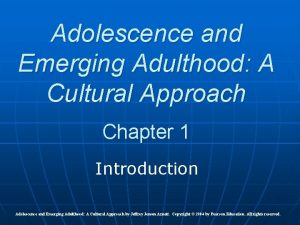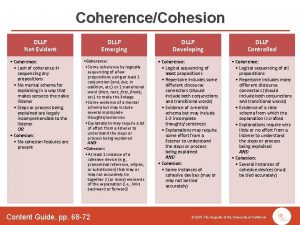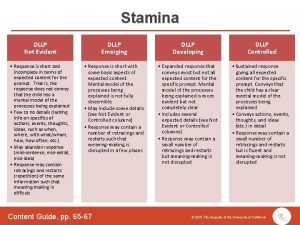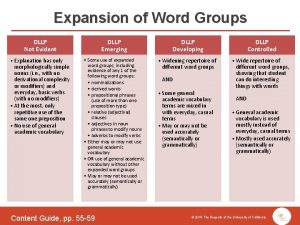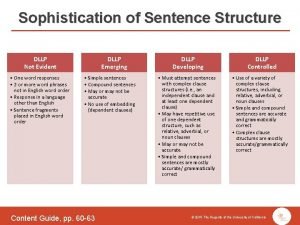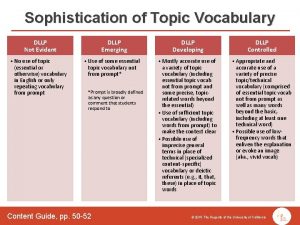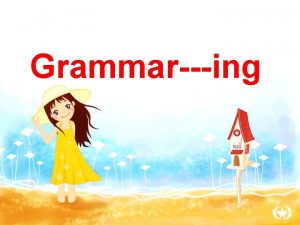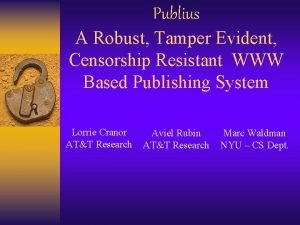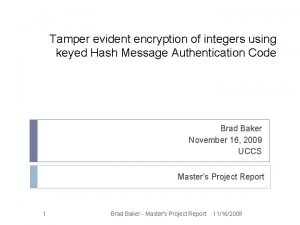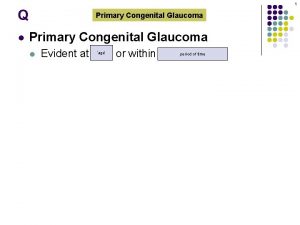CoherenceCohesion DLLP Not Evident DLLP Emerging DLLP Developing































- Slides: 31

Coherence/Cohesion DLLP Not Evident DLLP Emerging DLLP Developing DLLP Controlled • Coherence: • Lack of coherence in sequencing any propositions • No mental schema for explaining in a way that makes sense to the naïve listener • Steps or process being explained are largely incomprehensible to the listener OR • Cohesion: • No cohesion features are present • Coherence: • Some coherence by logically sequencing of a few propositions using at least 1 conjunction (and, but, in addition, etc. ) or 1 transitional word (then, next, first, finally, etc. ) to make the linkage • Some evidence of a mental schema but may include several incomplete thoughts/sentences • Explanations may require a lot of effort from a listener to understand the steps or process being explained AND • Cohesion: • At least 1 instance of a cohesive device (e. g. , pronominal reference, ellipsis, or substitution) that may or may not accurately tie together 2 (or more) elements of the explanation (i. e. , links backward or forward) • Coherence: • Logical sequencing of most propositions • Repertoire includes some different discourse connectors (should include both conjunctions and transitional words) • Evidence of a mental schema but may include 1 -2 incomplete thoughts/sentences • Explanations may require some effort from a listener to understand the steps or process being explained AND • Cohesion: • Some instances of cohesive devices (may or may not be tied accurately) • Coherence: • Logical sequencing of all propositions • Repertoire includes many different discourse connectors (should include both conjunctions and transitional words) • Evidence of a clear schema from which the explanation is crafted • Explanations require very little or no effort from a listener to understand the steps or process being explained AND • Cohesion: • Several instances of cohesive devices (must be tied accurately) Content Guide, pp. 68 -72 © 2015 The Regents of the University of California

Coherence and Cohesion • Along the progression, children displayed increasing abilities to employ sophisticated linguistic devices. Coherence and cohesion are achieved with the utilization of clear cohesive devices, sequencing with temporal discourse connectors, and use of complete sentences. Controlled Coherence and Cohesion (EL): Personal routine EL EO/P You need to brush your teeth because if you Coherence don't, you'll get a tooth Controlled and Cohesion to fall(EO/P): down. And you don't want a tooth to fall down because you want them. Because straight ahead for you cannot your teeth have to be super lose clean. tooths. And you have to when you're [Researcher: And can you telland done, you. Okay. put on your uniform him how to do it cause he doesn't you get your backpack. And then knowyou how? ] go in the car. And then your dad Firstcome you put toothpaste on the take you to school. toothbrush. Next you water it littlehim [Researcher: And can youa tell bit. And let it to dryclean for ahis littleteeth? ] howthen to doyou it? How bit. And brush. Firstthen you get your toothbrush, and Developing Coherence and Cohesion (EO/P): Emerging Coherence and Cohesion (EL): No Evidence of Coherence and Cohesion (EL): With a pasta. With the toothbrush. With the water. Spit out the water. [Researcher: And can you tell her why No Evidence of Coherence and Cohesion she(EO/P): should do it? ] She should do it for his teeth can be shiny always. Brush your teeth because you will get yellow teeth. No use of you sequencing [Can tell her connectors how to do or it? ] cohesive Get adevices toothbrush and brush your teeth. Because his teeth need and to be. Cohesion clean. Emerging Coherence And (EO/P): the bottom too, and his tongue. And he needs to clean in the sides. And Why thenyou he needs them it's shouldtodobrush it is because everybetter day. to Then heyour has to clean thewhy brush teeth. And otheryou side. should do it is because you can move your cavities if you have any. · Some and Andinstances how you of dosequencing it is you take a cohesive devicesand you put toothpaste on. toothbrush, You should brush your teeth because you don't want to get cavities. First you put toothpaste on your toothbrush. Then you brush your teeth. And then you put water on your toothbrush and brush it again. And then wash the toothpaste out of your mouth and then spit in the sink. And then shake your toothbrush and put it on the toothbrush holder. then the thing that you put on top. Use And of a variety of sequencing terms And then you brush your teeth. connecting most as to well as your then you go clauses, if you want wash cohesive devices face or your hair, you could do that. And I do that when I brush my teeth too. And then everything could be clean: your hair, your face, and your teeth. · Uses sequencing connectors in most utterances and a variety of cohesive devices · Use of a variety of sequencing connectors and cohesive devices And you start brushing your teeth. Yeah, that's it. · Some use of sequencing connectors and cohesive devices · No use of cohesive devices Not (yet) evident Emerging Developing Controlled © 2015 The Regents of the University of California

Coherence and Cohesion No Evidence of Coherence and Cohesion (EL): Personal routine EL EO/P No Evidence of Coherence and Cohesion (EO/P): With a pasta. With the toothbrush. With the water. Spit out theteeth water. Brush your because you will get yellow teeth. [And can you tell her why [Can you tell her how to doshe it? ]should do it? ] She ashould do it for hisbrush teethyour can be shiny always. Get toothbrush and teeth. • • • • Not (yet) evident No use of transitional Use of one conjunctionwords or conjunctions to sequence steps No use of cohesive devices No use of productive cohesive devices Emerging Developing Controlled © 2015 The Regents of the University of California

Coherence and Cohesion Emerging Coherence and Cohesion (EO/P): Personal routine EL EO/P Emerging Coherence and Cohesion (EL): Why you should do it is because it's better to brush your teeth. And you should it is because can too, Because hiswhy teeth need to bedoclean. And theyou bottom movehisyour cavities youneeds haveto any. Andinhow you do. And it is and tongue. Andif he clean the sides. you take a toothbrush, putday. toothpaste then he needs to brush and themyou every Then heon. has. And to you start your teeth. clean the brushing other side. • • Not (yet) evident Repetitive use of 1 conjunction (and) Repertoire includes 1 conjunction andto 1 sequence transitional steps word Use of of one 2 different cohesive (pronominal Use cohesive devices (pronominal referent) referent and substitution) Emerging Developing Controlled © 2015 The Regents of the University of California

Coherence and Cohesion Developing Coherence and Cohesion (EO/P): Personal routine EO/P So then you can eat healthy. And then you can make your food all clean, so you can eat healthy. And then if you eat healthy, your body gets big and strong. [Can you tell your friend how to clean your teeth because he doesn't know how? ] So you put toothpaste on it. And then you rinse it. And then you brush your teeth, so brush in this corner, then that corner, then brush in the middle. And then you can rinse your brush after you wash your teeth. And then get water and put it in the cup. And then swish it in your mouth. And then spit it out. • Repertoire includes 1 conjunction (and) and 2 transitional words (then, after) • Numerous instances of cohesive ties (pronominal referents; some ambiguous/inaccurate use) Not (yet) evident Emerging Developing Controlled © 2015 The Regents of the University of California

Coherence and Cohesion Controlled Cohesion (EO/P): Controlled. Coherenceand Cohesion (EL): Personal routine EL EO/P Because your be super clean. Anddon't, you have to get when You need toteeth brushhave yourtoteeth because if you'll a you're done, you put on your uniform and you get your backpack. tooth to fall down. And you don't want a tooth to fall down And then you in the car. straight And then your for dadyou come take you because yougo want them ahead cannot loseto school. tooths. [And can you tell him how to do it? How to clean his teeth? ] [Okay. And can you tell him how to do it, because he doesn't First you get your toothbrush, and then the thing that you put on top. know how? ] And then you brush your teeth. And then you go if you want to wash First you put toothpaste on the toothbrush. Next you water it a your face or your hair, you could do that. And I do that when I brush little bit. And then you let it dry for a little bit. And then you my teeth too. And then everything could be clean: your hair, your brush. face, and your teeth. Repertoire includes 2 conjunctions (and, then) 2 • • Repertoire includes 2 conjunctions (and, then) andand 2 transitional words (when, words first) (first, next) Several instances cohesive using types of • • Several instances of of cohesive ties using twotwo types of cohesive devices (ellipsis, pronominal referent) referents) Not (yet) evident Emerging Developing Controlled © 2015 The Regents of the University of California

Coherence and Cohesion • Along the progression, children displayed increasing abilities to employ sophisticated linguistic devices. Coherence and cohesion are achieved with the utilization of clear cohesive devices, sequencing with temporal discourse connectors, and use of complete sentences. Controlled Coherence and Cohesion (EL): Academic task EL EO/P Emerging Coherence and Cohesion (EL): You need to put the cubes in the top and count them. [Researcher: And can you tell him why this way helps? ] Emerging Coherence and Cohesion It helps you for you can count. (EO/P): No Evidence of Coherence and Cohesion (EL): Because there's six cubes. and Cohesion No Evidence of Coherence [Researcher: (EO/P): Can you tell her how to do it? ] One, How two, three, six. did youfour, usefive, the cubes? By [Researcher: you tell her why this counting. Can them. way helps? ] [Researcher: And can you tell her why Because he didn't know how to count. this way helps? ] · Use of some sequencing connectors As you stack them up, you can count and cohesive devices them. It's easy. [Can you tell her why this way helps? ] It helps me count a lot when I stack them up. Some use of sequencing connectors and cohesive devices Because you can learn. No use of sequencing connectors or cohesive No devices use of sequencing connectors Not (yet) evident Developing Coherence and Cohesion (EL): Developing Coherence and Cohesion (EO/P): First they need to count it and then they put it like. didn't put it. How you. And find they out how many cubes And then they put. You'll it. First they put them it there are? have to put in a together. theyand count. line. Then like this, then count them in [Researcher: Tell her why using the your mind. cubes [Researcher: this way helps. Okay. her. ] Perfect! And can Because youit's telleasy. her why this way helps? ] All bunchy like this. I will go like this. · Varied use of sequencing One, one, two, three, four, five, connectors and cohesive devices five, six, seven, eight, nine, ten. And I wouldn't know that. I would be like oh it's ten. But then it would be one, two, three, four, five, six, seven. It would normally be six. Another way to do it is to stack it up like this. And you just have to stack it up like this. And then count. And then put it down so it stays together. It's an easier way. So you stick it together, stack it up and then you put it down like this. And count them one, two, three, four, five, six. [Researcher: Anything else? ] You could count them with your fingers also like this one, two, three, four, five, six. So it has six then. You need to use the cubes to put them in line and then count them before you put them in line. And then you put them in line and then you start piling them more and more until you find out. [Researcher: Tell him why using the cubes this way helps him? ] Because you will learn and know already what is like three plus three or if you put them in line, you already know that there are six in all. Use of a variety of sequencing connectors and cohesive devices Uses a variety of sequencing connectors and cohesive devices Emerging Developing Controlled © 2015 The Regents of the University of California

Coherence and Cohesion No andand Cohesion (EL): (EO/P): No Evidenceofof. Coherence Cohesion Academic task EL EO/P Because six the cubes. How didthere's you use cubes? By counting them. [Can you tell her how to do it? ] [And can you tell her why this way helps? ] One, two, three, four, five, six. Because you can learn. [Can you tell her why this way helps? ] Because he didn't know how to count. • No use of sequencing connectors Useuse ofofone cohesiveconnectors device • • No sequencing • No use of cohesive devices Not (yet) evident Emerging Developing Controlled © 2015 The Regents of the University of California

Coherence and Cohesion Emerging Coherence and Cohesion (EL): Emerging Coherence and Cohesion (EO/P): Academic task EL EO/P You need to put the cubes in the top and count As you stack them up, you can count them. It's them. easy. [And can you tell him why this way helps? ] [Can you tell her why this way helps? ] It helps you for you can count. It helps me count a lot when I stack them up. • • Not (yet) evident Use of 1 conjunction (and) Use of two transitional words (as, when) Several instances of cohesive ties (pronominal referents) Emerging Developing Controlled © 2015 The Regents of the University of California

Coherence and Cohesion Academic task EL EO/P Developing Coherence and Cohesion (EO/P): How you find out Coherence how many cubes there are? You'll(EL): have to put them in a line like Developing and Cohesion this, and then count them in your mind. [Okay. Perfect! And can you tell her why this way helps? ] they need to go count it and they put it like. All. First bunchy like this. I will like this. One, then one, two, three, four, And five, six, they seven, eight, put nine, it. ten. And then I wouldn't I would be like, didn't theyknow putthat. it. First they put“oh it it's ten. ” Buttogether. then it would be one, two, three, four, five, six, seven. It would normally be six. Then they count. Another way to do it is to stack it up like this. And you just have to stack it up like [Tell using theput cubes this helps her. ] this. Andher thenwhy count. And then it down so way it stays together. It's an easier way. easy. stack it up and then you put it down like this. And count So. Because you stick itit's together, them one, two, three, four, five, six. [Anything else? ] • Repertoire includes 1 conjunctions (and) and 2 You could count them with your fingers also like this: one, two, three, four, five, six. Sotransitional it has six then. words (first, then) • Numerous instances of cohesive ties (pronominal • Repertoire includes (and, also) and 1 transitional word (then) referents; some 2 conjunctions ambiguous/inaccurate) • Numerous instances of cohesive ties (pronominal referents; some ambiguous/inaccurate) Not (yet) evident Emerging Developing Controlled © 2015 The Regents of the University of California

Coherence and Cohesion Controlled Coherence and Cohesion (EL): Academic task EL You need to use the cubes to put them in line and then count them before you put them in line. And then you put them in line and then you start piling them more and more until you find out. [Tell him why using the cubes this way helps him. ] Because you will learn and know already what is like three plus three or if you put them in line, you already know that there are six in all. • • Not (yet) evident Repertoire includes 1 conjunction (and) and 3 transitional words (then, before, until) Six instances of cohesive ties (pronominal referents) that are accurately tied Emerging Developing Controlled © 2015 The Regents of the University of California

Coherence and Cohesion • Along the progression, children displayed increasing abilities to employ sophisticated linguistic devices. Coherence and cohesion are achieved with the utilization of clear cohesive devices, sequencing with temporal discourse connectors, and use of complete sentences. Controlled Coherence and Cohesion (EL): Personal routine EL EO/P Developing Coherence and Cohesion (EL): First you get a toothbrush. Then you get this little soap. And then clean first in the left for thirty seconds and Coherence and Cohesion then. Developing right another thirty seconds. Then(EO/P): you go to the top and do Emerging Coherence and Cohesion (EL): No Evidence of Coherence and Cohesion (EL): So she could not go to the dentist. [Researcher: And can you tell her how to clean her teeth? ] With a toothbrush and some. No use of sequencing connectors or cohesive devices Not (yet) evident You get your brush. You get your hand. Put something like those. Emerging Coherence and Cohesion Then put your hand in your mouth (EO/P): and then you shake it in your mouth. Then you have to brush them OK. if. You teeth because youshould do notclean brushyour them, because you don't want yourdo teeth to will be ugly like that. Then if you yellow. youyour don't want to get brushturn your teeth And all day, teeth cavities. And how to do it is you put will be happy. toothpaste on your toothbrush, water a little, and thenconnectors pop it in your Someituse of sequencing and mouth and brush. cohesive devices another thirty seconds and the left So first should tell, Wethat's should get a another thirty. I seconds. And we should get goingtoothbrush to be two and minutes. And then toothpaste spread it on you should do itand because you canthe brush. And then it back and forth get germs and you all ofscrub that stuff that's in your molars and your front teeth. bad for your teeth. Yeah, that's how. [Researcher: And can you and tell her Variety of sequencing connectors whydevices she should do it? ] cohesive She should do it so she won't have to go to the dentist and get cavities if her teeth turn yellow and get all dirty. Variety of sequencing connectors and cohesive devices First, you need to turn on the water. And then you're gonna get your toothbrush and Coherence then put water on it. Controlled and Cohesion And then you get the toothpaste and (EO/P): put it on the brush. Then you water it a little. Well, bit. And then you brush your first you buy a toothbrush. teeth in circles. thenkind youofspit. And then And you just put a little And then after brush your water on itthat, by turning on the faucet bottom andput upthe teeth. And when and toothbrush under it. you're. Then done you withturn that, off spit. And getand you the water, some kind water, in toothpaste your mouthon and of put just itput it. And spit it then out and done. And youbit do ityou'll andbe then rinse a little shouldoff, brush teeth because not ayour lot of it. And then you start will betohandsome, teeth just scrapeand your teeth withwill it. And look clean, andjust yourdomouth will be then you the whole step fresh. over, but you don't clean your teeth again. And then you apply this Multiple sequencingor connectors mouthwash, you put itand in a cup. cohesive devices And then you just squish it around your mouth and then spit it out. And then it's important to do it because if you don't, you're teeth will fall out. And you get many cavities because you eat candy and stuff, and it's on your teeth, and it won't come off. Multiple sequencing connectors and cohesive devices Some use of sequencing connectors and cohesive devices Emerging Developing Controlled © 2015 The Regents of the University of California

Coherence and Cohesion No Evidence of Coherence and Cohesion (EL): Personal routine EL Not (yet) evident So she could not go to the dentist. [And can you tell her how to clean her teeth? ] With a toothbrush and some. • Use of conjunction does not serve the purpose of sequencing propositions • No use of cohesive devices Emerging Developing Controlled © 2015 The Regents of the University of California

Coherence and Cohesion Emerging Coherence and Cohesion (EL): (EO/P): Personal routine EL EO/P Not (yet) evident You get should yourclean brush. your You teeth get your because hand. you. Put don't something want your teeth like those. to turn Then yellow. put your And you handdon't in your mouth want toand getthen cavities. you And shake how it intoyour do itmouth. is you Then you put toothpaste have to brush on them your toothbrush, because if you water do not it a brush little, and them, then willpop be ugly it in your like that. mouth Then andifbrush. you do brush your teeth all day, your teeth will be happy. • Use of 1 conjunction (and) and 1 transition • Use wordof(then) 1 transitional word (then) • Use of cohesive devices (ambiguous (pronominal referents) Emerging Developing Controlled © 2015 The Regents of the University of California

Coherence and Cohesion Developing Coherence Cohesion (EO/P): Developing Coherenceand Cohesion (EL): Personal routine EL EO/P So first I should tell, “We should get a toothbrush and we First you get a toothbrush. Then you get this little soap. And then should get toothpaste and spread it on the brush. And then you clean first in the left for thirty seconds and then right another scrub it back and forth in your molars and your front teeth. ” thirty seconds. Then you go to the top and do another thirty Yeah, that's how. seconds and the left another thirty seconds. And that's going to be [And can you tell her why she should do it? ] two minutes. And then you should do it because you can get She should do it so she won't have to go to the dentist and get germs and all of that stuff that's bad for your teeth. cavities if her teeth turn yellow and get all dirty. • • Repertoireincludes 1 1 conjunction(and)and 2 2 transitionalwords (first, then) • • Numerous and Numerousinstancesofofcohesiveties(pronominalreferents, ellipses) substitution, and ellipses) Not (yet) evident Emerging Developing Controlled © 2015 The Regents of the University of California

Coherence and Cohesion Controlled Coherence and Cohesion (EO/P): Controlled Coherence and Cohesion (EL): Personal routine EL EO/P First yourto toothbrush, toothpaste it, and I First, take you need turn on theput water. And thenon you're gonna usually water onand it. then And then cleanonyour teeth by you doing get yourput toothbrush put water it. And then little circles on your teeth. then clean. Then youryou bottom get the toothpaste and put it. And on the brush. waterand it a your bit. top. And teeth. Clean front yourinteeth, the topthen of you little then you the brush yourofteeth circles. And your. And teeth, and thethat, backbrush of your teeth. And then fill a spit. then after your bottom and up after, teeth. And when you're doneswish with that, spit. And get mouth, some water, put it in cup with water, it around in your and then your mouth andout. spit. And it outyou andshould you'll be done. And you so should spit the water clean your teeth your brush becauseand you so willthey be handsome, and your teeth your don'tteeth get cavities don't get dirty. will look clean, and your mouth will be fresh. • Repertoire includes 1 conjunction (and) and 3 • Repertoire includes(first, 1 conjunction (and) and 4 transitional transition words then, after) (first, then, after, when) tied cohesive devices • words Multiple instances of accurately • 7 instances of cohesive devices (pronominal referents) (pronominal referents and ellipses) Not (yet) evident Emerging Developing Controlled © 2015 The Regents of the University of California

Coherence and Cohesion Along the progression, children displayed increasing abilities to employ sophisticated linguistic devices. Coherence and cohesion are achieved with the utilization of clear cohesive devices, sequencing with temporal discourse connectors, and use of complete sentences. Controlled Coherence and Cohesion (EL): Academic task EL EO/P Emerging Coherence and Cohesion (EL): No Evidence of Coherence and Cohesion (EL): By counting and by your mind can No Evidence of Coherence and Cohesion count. (EO/P): And why does using the [Researcher: cubes this way help her? Tell her that. ]Count by tens so it's easier to count by. [Researcher: you tell him why this For you can learn Can to count. way helps? ] Because it's andevices easy number to count · No use of cohesive by. You could use the cubes stick together or separate. And just you Cohesion could. Emerging use the Coherence cubes stickand together or (EO/P): separate for you could find out how many cubes they are. And when Sodone, whatifyou doyou is you're youshould want to, canshould them inmany. each color, then you write put down how Whenand you're how many in each And donecount you could just count all ofcolor. them, then how much gotanswer was I had ten in and it'll help you find Ithe faster. each. So I think I got forty-eight. It helped me to get my answersand Minimal use of sequence connectors because I can count them one by one, cohesive devices or two by two, or by a number. Developing Coherence and Cohesion (EL): You get a cube. You stack them up to each other. You stick them to each and when there's no more, Controlled Coherence and the Cohesion you stick the other ones and other(EO/P): ones together until there's no You should use it like that because it will be more easier. And put the cubes, get the cubes from each color and put it like this. And then Coherence and Cohesion when. Developing you already put it like that, count(EO/P): these, then count the other color. But don't put it like that, just cubes. them into count. Use the colors and Make everything. If it'sa groupamount and take a time. the same as two this out oneatthen Count them see how many you will know howtomany there is in you all. have. Finish doing that when the first And you should use it because if you is in itthe second one. Then countcluster it like that would be more you'll know how many cubes there easier. are. you tell him why using the cubes Use of[Can a variety of sequencing this way connectors andhelps? ] cohesive devices, even if It'sare faster than using them tied by ones. devices not always accurately more. And then you count them. first should putand all the And So then youhecount them youcubes. should cube color. could. First counthethem by pick fives, a tens, Thenfifteens. he should put them in order like twenties, blue. One of them can be using blue and [Researcher: And tell him why then this you way can do it with all the other the cubes helps him. ] colors. And after he does that, he It's easier because they're big and couldcount find out what. You each one is. Then you could them. could know whateasier the answer is. He counthe them and they're to countshould with. do it this way because this way he can know how many cubes are sequencing more easy connectors because they're Use ofthere multiple all in one stick. And you know that if and cohesive devices you don't know the answer for like this yellow one, then you could just see and you know that the white one's ten. And it's the same amount so it's ten. Use of a variety of sequencing connectors and cohesive devices Use of multiple sequencing connectors and cohesive devices Minimal use of sequence connectors and cohesive devices No evidence of sequencing connectors or cohesive devices Not (yet) evident Emerging Developing Controlled © 2015 The Regents of the University of California

Coherence and Cohesion No Evidence of Coherence and Cohesion (EL): No Evidence of Coherence and Cohesion (EO/P): Academic task EL EO/P By counting and by your mind can count. Count by tens so it's easier to count by. [And why does using the cubes this way help [Can you tell him why this way helps? ] her? Tell her Because it's that. ] an easy number to count by. For you can learn to count. Use of 1 conjunction (and) and 1 transition • Noword use of cohesive devices (then) • • Use ofofone conjunction Use cohesive devices (pronominal referents) • Not (yet) evident Emerging Developing Controlled © 2015 The Regents of the University of California

Coherence and Cohesion Emerging Coherence and Cohesion (EL): Academic task EL EO/P Emerging Coherence and Cohesion (EO/P): By learning and counting more easily. You stack this which would be [Cancould you tell himthem howup to like do it? ] pretty easy him because you put canthem keep and trackhow of I can show then he could how many you have. he could count. And how he could get to the numbers higher. • Use of 1 transition word (then) • Use of cohesive (pronominal Repetitive use ofdevice 1 conjunction (and)referent) • Use of 1 cohesive device (pronominal referent) Not (yet) evident Emerging Developing Controlled © 2015 The Regents of the University of California

Coherence and Cohesion Academic task EL EO/P Developing Coherence and Cohesion (EO/P): Developing Coherence and Cohesion (EL): Use the cubes. Make them into a group and take two out at a You use the cubes to see helphow youmany countyou andhave. you could them by time. Count them to Finishdo doing fives when since however you want. when you're done, you'll you that the first cluster is in. And the second one. Then have to count them. And thenare. you get the total of cubes. It know how many cubes there helpsyou youtell because it makes easier forthis youway to count. [Can him why using itthe cubes helps? ] It's faster than using them by ones. • Repertoire includes 1 conjunction (and) and 2 transitional • words Repertoire includes (when, then)1 conjunction (and) and 2 transitional words (when, then) instances of cohesive ties (pronominal referents) • Numerous instances of cohesive ties (pronominal referents) Not (yet) evident Emerging Developing Controlled © 2015 The Regents of the University of California

Coherence and Cohesion Controlled Coherence and Cohesion (EO/P): (EL): Controlled Coherence and Cohesion Academic task EL EO/P So first he should put all the cubes. First he should pick a cube color. Then Toshould find out are, One first findand out he put how them many in orderthere like blue. of you themhave can betoblue then if they're same color not. Andafter howhemany are there you can do the it with all the otherorcolors. does that, he could find out what each is. Then could know what the answer is. He all together. Andone when youhefind out how many there are should do it thisthen way you because wayanswer he can know many cubes all together findthis your and how it's more there are more easy because they're all in one stick. And you know that if easier this way because you don't need to be all stressed you don't know the answer for like this yellow one, then you could just out. and you know that the white one's ten. And it's the same amount so see it's ten. • Repertoire includes 1 conjunction (and) and 2 • transitional Repertoire includes (and) and 3 transitional words (first, words 1 conjunction (first, when, then) after, then) • Numerous instances of cohesive ties (pronominal referents, ellipses) substitution, ellipses) Not (yet) evident Emerging Developing Controlled © 2015 The Regents of the University of California

Coherence and Cohesion • Along the progression, children displayed increasing abilities to employ sophisticated linguistic devices. Coherence and cohesion are achieved with the utilization of clear cohesive devices, sequencing with temporal discourse connectors, and use of complete sentences. Controlled Coherence and Cohesion (EL): Personal routine EL EO/P Emerging Coherence and Cohesion (EL): No Evidence of Coherence and Cohesion (EL): Up and down. Side to side. Rinse. [Researcher: Can you tell him why he should do it? ] So he doesn't get bad breath. Lack of complete sentences, with no use of sequencing connectors or cohesive devices Not (yet) evident You brush your teeth by brushing your teeth on your front teeth, on your Emerging Coherence and Cohesion left and right teeth. Then brush for 20 (EO/P): seconds and wash off with water. And do the same routine again Well, you get a toothbrush. and If you for the same time or more if you want. don't have one, then go to the store And then wash off. Get again. and get one. toothpaste. Put the [Researcher: And tell her and toothpaste oncan theyou toothbrush why she should it? ]teeth good. And get brush all ofdo your You should brushout your all the food of teeth them every and yeah. day so you won't have not do [Researcher: And germs why heand should a badit? ] breath smell. And your teeth won't. To turn beyellow. clean. So he doesn't get cavities. And yeah. Some use of sequencing connectors and cohesive devices, but lacks complete sentences in some instances Emerging Developing Coherence and Cohesion (EL): Developing Coherence and Cohesion (EO/P): You need a toothbrush and you need supposed doititon likethe this: you paste. You're And you need totoput just get a toothbrush, the toothbrush and brush your put teeth it, and then you rub it upsidetoothpaste down andon side to side. And against your teeth astoothbrush hard as you can. after that, you clean your And you thenput you do iton allyour over the place, and then water even your tongue. And then after mouth. Then rinse it. And you should donesothat, spitget out the brushyou've your teeth youyou won't toothpaste, getlook some cavities and they you won't badwater, and then smell you spit out again. And then they won't thatit funky. you rinse out your mouth like that. youofget a little liquid that helps Use of. Then a variety sequencing you get moredevices white, and you spit connectors andeven cohesive it out again. [Researcher: Sorry, did you tell him why he should do it? ] You should also do it because people might think your breath might stink. And also you should do it to not get sick. First, if you want to have nice teeth that look white and don't look brownish and have food stuck to your teeth, you have to get toothpaste, mouthwash and Coherence a toothbrush. so Controlled and And Cohesion when (EO/P): you have a toothbrush, you put toothpaste on it and you start washing your teeth in circles. Then that, put So you first wet yourafter toothbrush, you spit the water out. When youitput some toothpaste on it, put in your water, mouth. you spit. I prefer it out. After, to put you it onget the side of the mouthwash and scrub and then my mouth and go across and do the spit it out. And of that's how youthe brush top part them, then backside, your teeth. brush then Hopefully the upperyou side. Andyour you scrub teeth. it for 20 seconds each. So do each [Okay side and can you tell her each frienduntil whyyou've for 20 seconds she should gottendotoit? ] the far side and do the next You should this because you don't layer. do And then once you're done, wannayou have nasty or you don't rinse off teeth the toothbrush. You spit want your breath to stink. it out. You get a cup, And fill ityou with water, don't want be mouth. ugly and your then teeth rinse to your look like you don't have house [Researcher: And acan you or also tell anything that. himlike why he should clean his teeth? ] You should really clean your teeth Use of because multiple sequencing connectors you don't want them to rot. and cohesive devices And you want be able to eat hard stuff. You'll only be able to eat kind of soft mushy stuff, like yogurt, I think, like oatmeal. Sorry about that. Use of multiple sequencing connectors and cohesive devices Use of a variety of sequencing connectors and cohesive devices Developing Controlled © 2015 The Regents of the University of California

Coherence and Cohesion No Evidence of Coherence and Cohesion (EL): Personal routine EL Up and down. Side to side. Rinse. [Can you tell him why he should do it? ] So he doesn't get bad breath. • Lack of complete sentences • Use of one conjunction • No use of cohesive devices Not (yet) evident Emerging Developing Controlled © 2015 The Regents of the University of California

Coherence and Cohesion Emerging (EL): Emerging. Coherenceand and. Cohesion (EO/P): Personal routine EL EO/P You brush your teeth by brushing your teeth on your front You get a toothbrush. If you don't have one, then go to teeth, on your left and right teeth. Then brush for 20 seconds the store and get one. Get toothpaste. Put the and wash off with water. And do the same routine again and toothpaste on the toothbrush and brush all of your teeth for the same time or more if you want. And then wash off good. again. And get all the food out of them. [And whyyou he tell should do it? ] [And can her why she should do it? ] To clean. brush So he doesn't cavities. Yoube should your teethget every day so you won't have germs and not a bad breath smell. And your teeth won't turn • yellow. Repertoire includes one conjunction (and) and one transitional word (then) • Repertoire includes one conjunction (and) and one • transitional Use of cohesive word devices (then) (pronominal referent and substitution) • Use of cohesive devices (ellipses and substitution) Not (yet) evident Emerging Developing Controlled © 2015 The Regents of the University of California

Coherence and Cohesion Developing Coherence (EO/P): Developing Coherenceand and. Cohesion (EL): Personal routine EL EO/P Firstneed you would take yourand toothbrush, the toothpaste You a toothbrush you needput paste. And you need where the bristles are, and put it in your mouth. Andupside start to put it on the toothbrush and brush your teeth scrubbing up and down, up and down. Then move it a little bit down and side to side. And after that, you clean your so it gets on the other side of your mouth, up and down, and toothbrush and then you put water on your mouth. Then the other side, up and down, for about two minutes or rinse it. And you should brush your teeth so you won't get something. Just wash off your toothbrush. Spit the toothpaste cavities they won't look bad and theyout, won't that stuff out. and Rinse your mouth out. Spit it back andsmell you're funky. done. • • Repertoire includesone oneconjunction (and) and Repertoire includes (and) and twotwo transitional words(first, (after, then) transitional words then) • Use of numerous cohesive devices referents, ellipses) cohesive(pronominal devices (pronominal referents, ellipses) Not (yet) evident Emerging Developing Controlled © 2015 The Regents of the University of California

Coherence and Cohesion Personal routine EL EO/P Not (yet) evident Controlled Coherence and Cohesion (EL): Controlled Coherence and Cohesion (EO/P): First, if you want to have nice teeth that look white and don't look So you first wet yourfood toothbrush. Put some it. Put it in brownish and have stuck to your teeth, toothpaste you have toonget your mouthwash I prefer to put the side of And my mouth and gohave across toothpaste, andit aontoothbrush. so when you a and do the top them, then backside, then the upper toothbrush, youpart put of toothpaste onthe it and you start washing yourside. teeth And you scrub for 20 seconds each. do each foryou 20 seconds in circles. Thenitafter that, you spit the. So water out. side When put each to the side do the next water, until youyou've spit it gotten out. After, youfar get theand mouthwash andlayer. scrub. And andthen once you're done, you rinsehow off the You spit it out. You then spit it out. And that's youtoothbrush your teeth. Hopefully youget a cup. your Fill itteeth. with water, and then rinse your mouth. brush [And he should clean his do teeth? ] [Okaycan andyou canalso youtellhim yourwhy friend why she should it? ] You should really youryou teeth because don't want them do thisclean because don't wannayou have nasty teeth or to yourot. And want bebreath able totoeat hard. And stuff. beyour ableteeth to eattokind don'tyou want your stink. you. You'll don'tonly want be of soft mushy stuff, you likedon't yogurt, oatmeal. ugly and look like havelike a house or anything like that. four transitional • Repertoire includes one conjunction (and) and three transitional words (first, when, then, after) then, once) • Use of numerous cohesive devices (pronominal referents, ellipses) substitution, ellipses) Emerging Developing Controlled © 2015 The Regents of the University of California

Coherence and Cohesion Along the progression, children displayed increasing abilities to employ sophisticated linguistic devices. Coherence and cohesion are achieved with the utilization of clear cohesive devices, sequencing with temporal discourse connectors, and use of complete sentences. Controlled Coherence and Cohesion (EL): Academic task EL EO/P Developing Coherence and Cohesion (EL): Emerging Coherence and Cohesion (EL): No Evidence of Coherence and Cohesion (EL): I think should use the tools No she Evidence of Coherence and Cohesion because (EO/P): maybe the tools is more easier for her to count them. Because maybe she doesn't knows her You should make groups oftens ten or using six. the cubes to find out how many there are because it's easier to count by tens Use than of one pronoun, sequencing doing it onebut byno one. connectors Emerging Cohesion He could use Coherence the cubes and by tens or (EO/P): twenties. And twenties is much more easier because it's longer and you Using the cubes in groups helps you use less space. because Anything it'd be easier to organize [Researcher: else? ] count easier them because So itthem couldand be much by using then know how much if you know tens you'll or twenties. how to count by fives and tens and twos. · Some use of sequencing connectors and [Researcher: And are cannot youalways tell her cohesive devices, which how totied how to do it? ] accurately To do it, he has to get a cube and then stack it on top to make the little group ten times. I used it that way for it could be easier to understand do it. So you could count by tens if you know how to count by tens. So if I did it by by separating it, you'll just get confused, sometimes, if you them Developing Coherence andput Cohesion in different (EO/P): order. And you should do it this way because it's an easier way for you to understand it. It helped me because I go faster and [Researcher: Can you tell her what to was counting. And it might help you do? ] because you might also go fast. So I First you get cubes that could attach suggest you use that way that I did. to each other. Then you put them [Researcher: And can you tell him rows by tens if you want to. Then how to do it? ] you count them by tens, and then The first way I did was connecting you'll see how much you have. them in one big line, and then I separated them into a bunch of lines. Use of a variety of sequencing And then I figured that wouldn't be connectors and cohesive devices very fast. So I decided to count the rest. You first got to look for the colors and got to put the colors and then make a ten pile. Make one of a little straight line and put it as a ten. Put ten of these cubes and make it until ten until you get to the end how much you need, how much you had. And then after, you could count them and then count them if there's any left, count the leftovers if you need to. [Researcher: Can. Coherence you tell him Controlled andwhy Cohesion this way helps? ] (EO/P): This will help how much they are and if you have of pile. having to count First any youproblem have your You know what number it could by ones where each possibly cube represents be. If your asks you howup much one. mom So you just count to ten. And cubes then do you have forand mathematical you grab you put it in a pile. problem, or then I'm thinking helpof them And you do that it forit'll each you with math. and you just do it until there's no more left. And then you just count it Use of multiple sequencing connectors up by how many you put in the pile, and cohesive devices and then you'll get the answer. Use of multiple sequencing connectors and cohesive devices Use of a variety of sequencing connectors and cohesive devices Some use of sequencing connectors and cohesive devices No use of sequencing connectors or cohesive devices Not (yet) evident Emerging Developing Controlled © 2015 The Regents of the University of California

Coherence and Cohesion No Evidence of of Coherence and Cohesion (EO/P): (EL): No Evidence Academic task EL EO/P IYou think she should use theof tools should make groups ten because using themaybe cubes the to tools is more easierthere for her tobecause count them. Because find out how many are it's easier to maybe she doesn't knowsither or six. count by tens than doing onetens by one. • • Not (yet) evident No No use of of sequencing connectors Use cohesive devices device (pronominal Use of of cohesive (pronominalreferent) referents) Emerging Developing Controlled © 2015 The Regents of the University of California

Coherence and Cohesion Emerging and Cohesion (EO/P): Emerging. Coherence and Cohesion (EL): Academic task EL EO/P Using the cubes in groups helps you because it'd be easier to He couldthem use the by tens or twenties. And organize andcubes count them because then you'll know how twenties is know muchhow more easierbybecause longer and much if you to count fives andit's tens and twos. you space. [Anduse can less you tell her how to do it? ] To do it, he else? ] has to get a cube and then stack it on top to [Anything make the little times. So it could be group muchten easier by using tens or twenties. • Repertoire includes one conjunction (and) and one • transitional Repertoireword includes one conjunction (and) (then) • • Useofofcohesive devices (pronominal referents and ellipses) Not (yet) evident Emerging Developing Controlled © 2015 The Regents of the University of California

Coherence and Cohesion Developing Coherence andand Cohesion (EL): (EO/P): Developing Coherence Cohesion Academic task EL EO/P IItused it that for it could easier to understand do it. So you helped meway because I go be faster and was counting. And could tens if you know how to also countgo byfast. tens. So So Iifsuggest I did it by mightcount help by you because you might by separating it, you'll just get confused, sometimes, if you put them you use that way that I did. in different order. And you should do it this way because it's an easier [And can tell him how way for youyou to understand it. to do it? ] The way I did was connecting them in one big line, and [Can first you tell her what to do? ] then I separated intoattach a bunch of lines. And then figured First you get cubes them that could to each other. Then you. Iput that be ifvery decided to count them wouldn't rows by tens you fast. want So to. IThen you count themthe by rest. tens, and then you'll see how much you have. • Repertoire includes one conjunction (and) and two transitional • words Repertoire (first, includes then) one conjunction (and) and two transitional • Use words of (first, cohesive then) devices (pronominal referents, ellipses, • substitution) Use of cohesive devices (pronominal referents, ellipses) Not (yet) evident Emerging Developing Controlled © 2015 The Regents of the University of California

Coherence and Cohesion Controlled Coherence and Cohesion (EO/P): Controlled Coherence and Cohesion (EL): Academic task EL EO/P First you put two and make them go down the table until you don't You to look foron thethe colors and. Then got to putgo the androw thenand havefirst anygot more space table. you tocolors the next make a ten Make one those. of a little straight line and it as a ten. Put put the nextpile. ones behind And then keep on put doing that until ten these and But make it until youin get to the end you howput much youof run out cubes of cubes. you stackten theuntil cubes twos when you need, how much youthen had. in. And you could them and them in the rows. And thethen end, after, depending on count how much you then count them if there's any left, count the leftovers if you need to. have in each row, you just count up how many are in each row and [Can you tell him why this way helps? ] you count by how many that there are in each row. And you go, like This will help how much they are and if you have any problem of having to for me it would be 8, 16, 24, 32, 40, 48, 56. But if it's something like know what number it could possibly be. If your mom asks you how much different, then youfor just count by how many or that It also that helpsit'll byhelp it's cubes do you have mathematical problem, I'mis. thinking faster to math. use it and more convenient, so that you wouldn't have to you with spend as much time doing it. • Repertoire includes one conjunction (and) and three transitional • words Repertoire two conjunctions (and, also) and four (first, includes then, after) transitional words/phrases (first, (pronominal then, when, referents, in the end) • Use of numerous cohesive devices ellipses, • substitution) Use of multiple cohesive devices (pronominal referents, substitution, ellipses) Not (yet) evident Emerging Developing Controlled © 2015 The Regents of the University of California
 History of quantum dots
History of quantum dots Teeth verb forms
Teeth verb forms We hold these truths to be self evident
We hold these truths to be self evident Self-evident
Self-evident Gaya pemikiran self evident truth
Gaya pemikiran self evident truth Chapter 2 building confidence
Chapter 2 building confidence Behold these truths to be self evident
Behold these truths to be self evident It is evident that want peace
It is evident that want peace Tamper resistant packaging definition
Tamper resistant packaging definition Petulant synonym
Petulant synonym Not genuine, not true, not valid
Not genuine, not true, not valid It infrastructure and emerging technologies
It infrastructure and emerging technologies Jeffrey arnett emerging adulthood theory
Jeffrey arnett emerging adulthood theory Trs ppms pay
Trs ppms pay Emerging technology chapter 5
Emerging technology chapter 5 Emerging trends in disaster management
Emerging trends in disaster management Marketing strategies for emerging markets
Marketing strategies for emerging markets Eld emerging expanding bridging
Eld emerging expanding bridging Swinburne emerging leader
Swinburne emerging leader Atlas of emerging jobs
Atlas of emerging jobs Emerging europe and the byzantine empire
Emerging europe and the byzantine empire Emerging markets inflation
Emerging markets inflation An emerging world power
An emerging world power Emerging trends in community development
Emerging trends in community development Trish livingston deakin
Trish livingston deakin Epidemiological triad
Epidemiological triad Cognitive development in emerging adulthood
Cognitive development in emerging adulthood Is nigeria a newly emerging economy
Is nigeria a newly emerging economy Challenges of international business in emerging markets
Challenges of international business in emerging markets Memory technology in computer architecture
Memory technology in computer architecture Emerging trends in software engineering ppt
Emerging trends in software engineering ppt Jeffrey arnett emerging adulthood theory
Jeffrey arnett emerging adulthood theory
